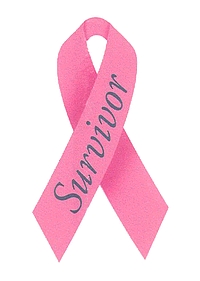October is Breast Cancer Awareness Month!
According to the National Breast Cancer Foundation, Inc., one in eight women will develop breast cancer at some point in her life – a statistic which equally affects all women. Although these numbers are distressing, basic steps can be taken to minimize our chances of developing the disease, and for early detection. While these actions are not guaranteed to eliminate risk, they can help minimize it, and will contribute to our overall health and ability to fight the disease if diagnosed:
Healthy Diet: a nutritious, low-fat diet (less than 30 grams) which includes PLENTY of fruits, and green and orange vegetables can help reduce breast cancer risk. (On the contrary, high-fat diets increase the risk in that fat triggers estrogen production which can fuel tumor growth.)
Exercise: exercise boosts our immune system and helps us keep a healthy weight level. Three hours of exercise per week (or 30 minutes per day) has been found to help women lower their risk of breast cancer. Power walking has proven very effective.
Encourage: remind friends and family to set up their personal plan for awareness, education and early detection. Create a “Buddy System” to remind each other of monthly Breast Self Exams, annual checkups, and the benefits of maintaining a healthy lifestyle.
There are also techniques to increase the chances of early detection, which can lead to successful treatment of the disease with less invasive surgical procedures:
Breast Self Exam (BSE): while all women should know the geography of their own breasts, a monthly breast self-exam (BSE) is one of the best methods for early detection of breast cancer. Look and feel for changes in breast tissue, including size, a palpable lump, puckering or dimpling of the breast, or redness/scaliness of breast skin. Also check for inversion of the nipple/areola section, discharge or secretions from the nipple, inversion of the nipple, or redness/scaliness of the nipple/areola area. Detection of a persistent lump in your breast or any other changes indicates that you see a physician immediately. While 8 out of 10 lumps are benign, medical evaluation is required to confirm that they are not cancerous.
Annual physical: yearly checkups including a clinical breast exam and pelvic exam are key in maintaining a healthy lifestyle, and in early detection of breast cancer or other diseases.
Mammography: the American Cancer Society and the National Comprehensive Cancer Network both recommend that women over 40 should have a mammography each year. While it compresses the breasts and can cause slight discomfort for a brief period, this type of screening is the best breast cancer screening tool today. Women with higher risks should always consult their gynecologist for special mammography guidelines.
Specific behaviors and exposures can elevate the risk of breast cancer:
Smoking: a lifestyle which includes smoking is a confirmed risk factor for breast cancer as well as many other forms of cancer. Smoking also directly contributes to heart and lung diseases. Second hand smoke is also a risk factor for cancer.
Alcohol: when consuming alcohol, moderation is the key. Alcohol increases estrogen levels in the bloodstream, and studies have shown that one drink per day can slightly increase the risk of breast cancer. Consuming more than one drink per day is linked to more significant risk, regardless of alcohol content – beer, wine or mixed drinks.
Birth Control Pills: studies indicate there is also an increased risk of breast cancer in women who have used birth control pills for five+ years. However, today’s lower level of hormones in birth control pills keep the risk level relatively low.
Stress: research indicates that factors such as traumatic events and catastrophic losses can alter immune system functions. When immune functions are altered, cancer cells may more easily establish themselves within the body. Research also indicates that when major life crises occur, how an individual reacts and/or copes with the event is directly related to how severely the immune system is altered.
Other Risks: the number of menstrual cycles a woman has over time can influence her risk of developing breast cancer. Women who are at a higher risk for breast cancer:
- began their menstrual cycle before the age 12, or
- have no biological children, or
- gave birth to their first child at age 30+, or
- began menopause after 55
According to The National Breast Cancer Foundation Inc., although women who have a family history of breast cancer are considered to be in a higher risk group, statistically only 5-10% of those diagnosed with breast cancer actually have a family history of the disease.
Breast Cancer Treatment
Treatment options for breast cancer are vast and are based partially on the following factors:
- stage of breast cancer
- type of breast cancer
- personal age and level of health
- history (personal and family)
The most common treatments for breast cancer are:
Surgery
If the cancer is detected early enough, there options which involve removing the cancer while preserving breast tissue. The most common options in early detection are a lumpectomy (typically followed by breast radiation treatments) and/or a partial mastectomy. Based on the factors listed above and others considered by your surgeon surgical options to remove and treat breast cancer include:
- Lumpectomy involves removing the cancerous tumor and in addition to a rim of potentially healthy tissue (a margin) tissue with a lab test to ensure that the margins are clear. A lumpectomy is the least invasive of the surgeries.
- Partial Mastectomy requires that the surgeon removes a larger portion of the breast than in the lumpectomy. It is more invasive and often entails removal of a segmant or quadrant of tissue, and perhaps some lining over the chest muscles as well.
- Skin-Sparing Mastectomy involves the removal of the breast, nipple, areola, and sentinel lymph node(s) but not the breast skin. This procedure is ideal for women who plan to undergoe breast reconstruction after treatment.
- Simple Mastectomy/Total Mastectomy also requires removal of the breast, nipple, areola, and sentinel lymph node(s) while leaving the chest wall and the outlying/distant lymph nodes intact.
- Modified Radical Mastectomy involves the removal of the entire breast, nipple, areola, and axillary lymph nodes but often leaves the chest wall intact.
- Radical Mastectomy involves removing the entire breast, nipple, areola, axillary lymph nodes and the chest wall. This procedure was more common in the past; however, instances remain where this surgery is the best option for treating breast cancer.
https://www.youtube.com/watch?v=14jz2dGMzo8
Therapy and Treatment
- Chemotherapy Treatment is a method that utilizes a combination of drugs to either destroy cancer cells or slow their growth. It is a systemic therapy, meaning that the drugs travel in the bloodstream throughout the body. The drugs are considered Cytotoxic (translates to “toxic to cells”), and are administered intravenously or orally.
- Radiation Therapy/Radiotherapy utilizes high-energy rays to kill the cancer cells. Radiation affects only the cells in the part of the body that is being treated. For example, in breast cancer treatment, radiation therapy can be used to destroy “mutated” cells that remain in the area after surgery. Radiation therapy is a common treatment in patients with stage 0 or Stage 1 invasive cancer and higher, and who’ve undergone a lumpectomy. It is also used after the main treatment as an adjuvant therapy to lower the chance of the breast cancer returning.
- Hormone Therapy can be used in patients who have breast cancer cells with receptors that feed on estrogen or progesterone, which stimulate their growth. Doctors may recommend hormone therapy drugs called blockers or inhibitors to starve and kill the cancer cells by cutting off their supply of the hormones. The most commonly used hormone therapy drug is Tamoxifen. Hormone inhibitors work by reducing the body’s hormone production. When breast cancer cells are cut off from their hormonal the tumor starves. Hormone therapy is commonly used in conjunction with chemotherapy for a greater combined treatment effect.
There are countless resources and programs available for patients fighting breast cancer. Widely considered the gold standard in the mission to end breast cancer, the Susan G. Komen Organization gathers research funding and inspires awareness through publicity, education and events, including the 3-day 60-mile “Race for the Cure.” The Komen organization recently provided $2.3 million in grant money to aid breast cancer patients and their families. And local breast cancer programs are found in communities everywhere. Each year, through fundraising dinners, concerts, events such as the Brenda’s Breast Cancer Dance Benefit and more, breast cancer awareness funding and research steadily improves, allowing us the opportunities to strengthen our fight against this vicious disease.
Test your Breast Cancer IQ at the American Cancer Society’s Breast Cancer Quiz.
[contact-form-7 id=”4″ title=”Contact form 1″]







I really enjoyed this article wow. So much information and you made it easy to understand. thank you